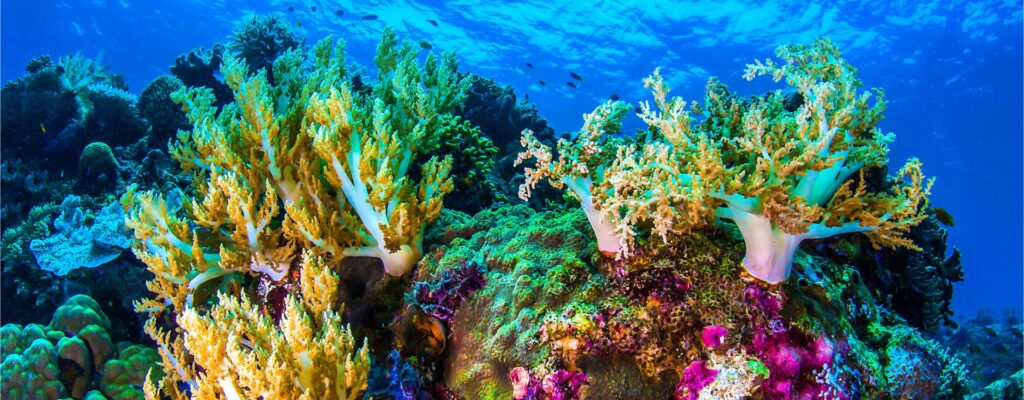From the CO2Science Archive: So-called ocean acidification (OA) is defined as the future decline in seawater pH that is expected to result in consequence of rising atmospheric carbon dioxide concentrations. By the year 2100, for example, it is estimated that enough CO2 will have been absorbed by the world oceans to cause a 0.3 to 0.4 pH unit decline, which reduction has been projected to wreak havoc on marine life, including possibly driving some species to extinction. However, much remains to be learned about this topic, for in the words of Kline et al. (2015), “a significant knowledge gap in our understanding of OA impacts on coral reefs lies in understanding the exposure of reefs to natural variability in OA-relevant parameters on different time-scales.” In an effort to begin filling this critical void, the fourteen-member research team of Kline et al. undertook to intensely measure a number of important carbonate chemistry and environmental parameters on the Heron Island reef flat, near the southern end of the Great Barrier Reef (23.45°S, 151.92°E), over a period of 200 days from June through December of 2010.
Paper reviewed: Kline, D.I., Teneva, L., Hauri, C., Schneider, K., Miard, T., Chai, A., Marker, M., Dunbar, R., Caldeira, K., Lazar, B., Rivlin, T., Mitchell, B.G., Dove, S. and Hoegh-Guldberg, O. 2015. Six month in situ high-resolution carbonate chemistry and temperature study on a coral reef flat reveals asynchronous pH and temperature anomalies. PLoS ONE 10: e0127648, doi:10.1371/journal.pone.0127648.
Among their findings, the researchers report observing large variability in daily pH values (see Table 1, pink shaded values), with differences often exceeding the magnitude of the predicted decline by 2100 (see Figure 1). What is more, they note that “as with many other reefs, the nighttime pH minima on the reef flat were far lower than pH values predicted for the open ocean” by the end of this century.
With regard to the cause of this variability, Kline et al. say it was “primarily modulated by biologically-driven changes in dissolved organic carbon and total alkalinity, rather than salinity and temperature.” And in further explanation they write that “in essence, to a large extent reefs modulate their own exposure to pH, especially in back-reef zones that are sometimes isolated from open ocean water. Reefs are both experiencing pH diel cycles, but they are also contributing to the actual range of the diel cycle.”
Such observations demonstrate the complexity of projecting both the degree of future pH decline and the response of marine life -- such as corals -- to that decline. Commenting on these problems, Kline et al. counsel that “natural environmental variability needs to be closely replicated in [OA experiments]” because such variability (e.g., daily fluctuation in pH) “will likely [1] impact coral reef physiological and ecological responses, [2] will ensure more biologically-relevant results, and [3] will be critical to understanding the impacts of local and global stressors in a high CO2 future.”
Indeed, and until that natural variability is properly replicated in OA experiments, the response of marine life to future declines in oceanic pH must be taken with a large grain of salt.

Table 1. Monthly environmental data summary statistics including the average diel means, average diel minimum, average diel maximum and diel range for temperature, pH and pCO2 (± SD). See the source (Kline et al., 2015) for details on how these statistics were calculated.

Figure 1. High-resolution pH (blue line) and pCO2 (green circles) measurements for Heron Reef for two weeks in June (austral fall) and December (austral spring) of 2010. Adapted from Kline et al. (2015).



The whole concept of ocean acidification appears to be on very shaky grounds. The oceans contain almost 50 times as much CO2 as the atmosphere and have a lot less volume than the atmosphere (oceans occupy 70% of the global surface, atmosphere occupies 100%; average ocean depth is about 12,000 ft, and the atmosphere extends upwards many times this amount). Consequently, the concentration of CO2 in the oceans is over 100 times that of the atmosphere, and yet with all this CO2 the oceans are comfortably alkaline. Since CO2 dissolved in pure water will be acidic, we can assume that the oceans must be buffered by some other dissolved component, so adding a little more CO2 is most unlikely to change its pH value significantly.
Perhaps the half billion years of marine carbonate production residing now as 8% of the earth's crust buffering all water runoff has some effect. You know, that turquois coloured water running through the Rocky Mountains for example.
According to the article, even if there were a 0.4 pH unit decrease, the oceans would still be slightly basic. And if the oceans warm with the atmosphere, they will give off CO2 as the warmer water can dissolve less, to counterbalance the increase in the C)2 concentration in the atmosphere. It’s a complex relationship. And since there has been far more CO2 in the atmosphere, and much warmer and colder temperatures at that higher concentration, it would seem ocean life has the ability to deal with what ever will result this time…